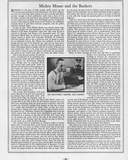
Bankers to the host of little studios which clutter up the motion-picture industry are the distributors. For short subjects, one and two reels long, their custom is to pay a certain sum (usually enough to cover production costs) and a share of the box-office receipts over and above this advance. Distributors look on most shorts as a necessary evil. Full-length pictures bring from twenty to fifty times as much rental in the theatres, but exhibitors demand shorts to pad their two-hour programs, and the public patiently endures them.
As late as 1931, when Mickey Mouse was already three years old, Walt Disney was still dependent on Columbia Pictures, distributor of his films. Production costs had risen from $5.400 a cartoon to $13,500, and Disney still demanded more. In 1932 Universal offered him an advance of $15,000 per picture; but Disney turned it down. Carl Laemmle, President of Universal, told him plainly that it was a grievous error to spend so much on an animated cartoon. But Disney was stubborn: he had just bought his way out of all financial ties, and now he went on to finance his own films, so that he could spend what he pleased on them. This season Disney’s budget calls for an outlay of $17,500 on each production. That is far more than any non-Disney cartoon costs, with or without color, but Disney insists that his corresponding profits at the world’s box office are worth the added outlay.
Add to that $27,500 another $17,500 for prints (Technicolor is an expensive process, and prints wear out after a while) and about $5,000 for advertising, shipping, taxes, foreign duty on exported prints, and various other small items. These are Disney's own estimates of his expenses, and they bring the total cost of his films to about $50,000 each. And how does he get that back? Under the terms of his agreement with United Artists, which now distributes his pictures, he is paid a simple percentage of the gross receipts. Since that percentage is on a sliding scale, it can hardly be reduced to a definite figure. But we may assume that he gets no less than 60 per cent of the rentals paid for his cartoons by all theatres, foreign and domestic, which exhibit them.
[…]